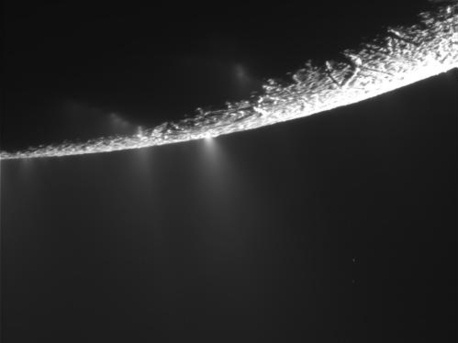Enceladus' Mighty Plume
Cassini Sends Back Images of Enceladus as Winter Nears
 © NASA/JPL/Space Science Institute
|
This unprocessed image was captured by NASA's Cassini spacecraft during its Nov. 21, 2009 flyby of Saturn's moon Enceladus. It shows the moon's south polar region, where jets of water vapor and other particles spew from fissures on the surface.
Scientists are particularly interested in the tiger stripes, which are fissures in the south polar region, because they spew jets of water vapor and other particles hundreds of kilometers, or miles, from the surface. This flyby was scientists' last peek at the tiger stripes before the south pole fades into the darkness of winter for several years. The thermal imaging work focused on the tiger stripe known as Baghdad Sulcus.
The Nov. 21 encounter, which is sometimes called "E8" because it is the eighth targeted flyby of Enceladus, brought Cassini to within about 1,600 kilometers (1,000 miles) of the moon's surface, at around 82 degrees south latitude. Cassini is now cruising toward Rhea, another one of Saturn's moons, for more imaging and mapping work.
To see a full gallery of raw images click here.
Source: NASA, JPL
Enceladus' Mighty Plume
Cassini Sends Back Images of Enceladus as Winter Nears
 © NASA/JPL/Space Science Institute
|
This unprocessed image was captured by NASA's Cassini spacecraft during its Nov. 21, 2009 flyby of Saturn's moon Enceladus. It shows the moon's south polar region, where jets of water vapor and other particles spew from fissures on the surface.
Scientists are particularly interested in the tiger stripes, which are fissures in the south polar region, because they spew jets of water vapor and other particles hundreds of kilometers, or miles, from the surface. This flyby was scientists' last peek at the tiger stripes before the south pole fades into the darkness of winter for several years. The thermal imaging work focused on the tiger stripe known as Baghdad Sulcus.
The Nov. 21 encounter, which is sometimes called "E8" because it is the eighth targeted flyby of Enceladus, brought Cassini to within about 1,600 kilometers (1,000 miles) of the moon's surface, at around 82 degrees south latitude. Cassini is now cruising toward Rhea, another one of Saturn's moons, for more imaging and mapping work.
To see a full gallery of raw images click here.
Source: NASA, JPL






